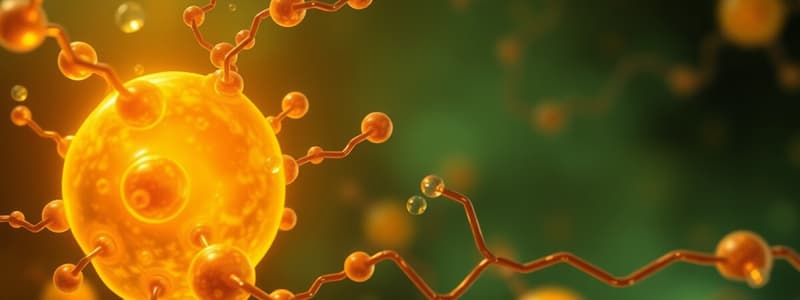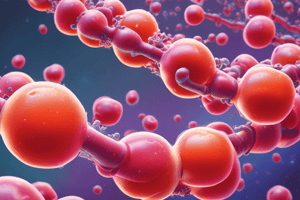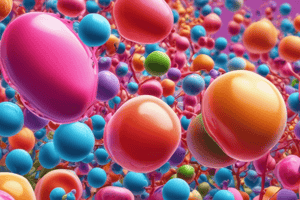Podcast
Questions and Answers
What is the purpose of adding KHSO4 to the powdered glycerol solution?
What is the purpose of adding KHSO4 to the powdered glycerol solution?
- To create an emulsion
- To neutralize the solution
- To increase the solubility of lipids
- To dehydrate glycerol (correct)
What does the peculiar odor produced during the heating process primarily indicate?
What does the peculiar odor produced during the heating process primarily indicate?
- The formation of acrolein (correct)
- Burnt carbohydrates
- The presence of alcohol
- Decomposition of fatty acids
What should be done with the ether-alcohol extract before conducting the acrolein test?
What should be done with the ether-alcohol extract before conducting the acrolein test?
- Mix it with sulfuric acid
- Dilute it in water
- Evaporate it to a syrupy consistency (correct)
- Cool it to room temperature
Which part of the ether-alcohol extract is used for the acrolein test?
Which part of the ether-alcohol extract is used for the acrolein test?
What role do the glass beads play in the Erlenmeyer flask during heating?
What role do the glass beads play in the Erlenmeyer flask during heating?
What happens to glycerol when it is heated in the presence of KHSO4?
What happens to glycerol when it is heated in the presence of KHSO4?
What is the main component in the ether-alcohol extract that is tested for during the experiments?
What is the main component in the ether-alcohol extract that is tested for during the experiments?
Why should the evaporation of the extract be done without flame?
Why should the evaporation of the extract be done without flame?
What property of glycerol allows it to be miscible with water?
What property of glycerol allows it to be miscible with water?
Which statement about glycerol is incorrect?
Which statement about glycerol is incorrect?
In which solvent is glycerol insoluble?
In which solvent is glycerol insoluble?
Which functional groups are primarily responsible for the solubility of glycerol in water?
Which functional groups are primarily responsible for the solubility of glycerol in water?
Which property classifies glycerol as hydrophobic despite its miscibility with water?
Which property classifies glycerol as hydrophobic despite its miscibility with water?
What is a notable characteristic of glycerol in terms of physical properties?
What is a notable characteristic of glycerol in terms of physical properties?
What conclusion can be drawn about the role of lipids regarding lung surfactant?
What conclusion can be drawn about the role of lipids regarding lung surfactant?
In the context of chemical testing, what does the acrolein test specifically indicate?
In the context of chemical testing, what does the acrolein test specifically indicate?
What are the primary functions of Type I pneumocytes in the alveoli?
What are the primary functions of Type I pneumocytes in the alveoli?
Which lipid component is primarily responsible for the surface-active properties of lung surfactant?
Which lipid component is primarily responsible for the surface-active properties of lung surfactant?
What causes alveoli to have an innate tendency to collapse?
What causes alveoli to have an innate tendency to collapse?
How do Type II pneumocytes contribute to lung function?
How do Type II pneumocytes contribute to lung function?
What is the effect of a pure film of DPPC on surface tension under dynamic compression?
What is the effect of a pure film of DPPC on surface tension under dynamic compression?
Which characteristic of saturated palmitic acids allows DPPC to stabilize the surface tension?
Which characteristic of saturated palmitic acids allows DPPC to stabilize the surface tension?
What percentage of alveolar cells do Type II pneumocytes comprise?
What percentage of alveolar cells do Type II pneumocytes comprise?
What is the primary role of surfactant in the alveoli?
What is the primary role of surfactant in the alveoli?
What is the primary intervention for a mother with a fetus at 26 weeks gestation to prevent respiratory distress syndrome (RDS)?
What is the primary intervention for a mother with a fetus at 26 weeks gestation to prevent respiratory distress syndrome (RDS)?
How does the administration of glucocorticoids shortly before delivery affect fetal development?
How does the administration of glucocorticoids shortly before delivery affect fetal development?
What method is used to deliver surfactant in the prevention and treatment of infant RDS?
What method is used to deliver surfactant in the prevention and treatment of infant RDS?
Which of the following is NOT typically considered a treatment option for preventing respiratory distress syndrome in preterm infants?
Which of the following is NOT typically considered a treatment option for preventing respiratory distress syndrome in preterm infants?
What is DCCP, which is facilitated by glucocorticoid administration during pregnancy?
What is DCCP, which is facilitated by glucocorticoid administration during pregnancy?
What is the primary component of lung surfactant responsible for reducing surface tension?
What is the primary component of lung surfactant responsible for reducing surface tension?
During which stage of lung development do components of the surfactant system begin to appear?
During which stage of lung development do components of the surfactant system begin to appear?
What is an indicator of fetal lung maturity that reflects the synthesis of DPPC?
What is an indicator of fetal lung maturity that reflects the synthesis of DPPC?
Which type of cell in the alveoli is primarily responsible for gas exchange?
Which type of cell in the alveoli is primarily responsible for gas exchange?
What condition can lead to respiratory distress syndrome (RDS) due to insufficient surfactant?
What condition can lead to respiratory distress syndrome (RDS) due to insufficient surfactant?
At approximately what gestational age does the synthesis of surfactant begin in Type II alveolar cells?
At approximately what gestational age does the synthesis of surfactant begin in Type II alveolar cells?
What is a potential outcome of inadequate surfactant production in preterm infants?
What is a potential outcome of inadequate surfactant production in preterm infants?
Which lipids primarily make up a significant part of lung surfactant?
Which lipids primarily make up a significant part of lung surfactant?
Study Notes
Lipid Metabolism Overview
- Lipids are crucial for various biological functions including energy storage and cell membrane structure.
- Phospholipid metabolism involves surfactant production, essential for lung function.
Experimental Procedures
- Total lipid extraction involves homogenizing tissue in ether-alcohol, filtering to separate lipid components.
- Triglycerides are isolated using hot water bath evaporation to a syrupy consistency before testing glycerol and lecithin.
- Glycerol is a polyol compound with three hydroxyl groups, making it miscible with water, while being hydrophobic due to fatty acid attachment.
- Acrolein test detects glycerol by heating with potassium bisulfate (KHSO4), resulting in a pungent odor indicative of dehydration products.
Role of Lipids in Lung Surfactant
- Surfactant is composed of approximately 70-80% phospholipids, mainly dipalmitoylphosphatidylcholine (DPPC), and is critical for reducing surface tension in alveoli.
- Surfactant therapy effectively reduces the incidence and severity of respiratory distress syndrome (RDS) in preterm infants.
- Lung maturity is assessed by the lecithin/sphingomyelin (L/S) ratio in amniotic fluid, a ratio of 2 or above signals sufficient surfactant production.
Lung Structure and Function
- Alveoli, the gas exchange sites in lungs, consist of Type I and Type II epithelial cells:
- Type I cells (95%) line the alveolar walls and facilitate gas exchange.
- Type II cells (5%) synthesize and secrete surfactant.
- Surfactant lowers surface tension to prevent alveolar collapse, stabilizing the alveoli's spherical shape.
Surfactant Composition
- DPPC is the primary active component in surfactant, maintaining low surface tension during inhalation and exhalation.
- Saturated palmitic acids in DPPC allow for organization into a stable two-dimensional gel structure at body temperature.
Prevention and Treatment of RDS
- Glucocorticoids, such as hydrocortisone, administered to mothers can accelerate fetal lung maturation by enhancing DPPC production.
- Natural or synthetic surfactant can be administered intratracheally to treat or prevent RDS in preterm infants, especially those born before 28 weeks of gestation.
Key Questions
- Identify the epithelial cell types found in alveoli:
- Type I (gas exchange)
- Type II (surfactant production)
- Significance of lung surfactant: reduces surface tension, preventing alveolar collapse and facilitating efficient gas exchange.
Studying That Suits You
Use AI to generate personalized quizzes and flashcards to suit your learning preferences.
Description
This quiz covers the extraction and metabolism of lipids, focusing specifically on phospholipids and sphingolipids. Participants will explore the solubility characteristics of lipids in various solvents. Dive into the fascinating world of lipid metabolism with this comprehensive quiz.




